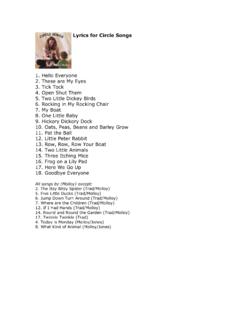Transcription of How to estimate the value of - Mit Blossoms
1 How to estimate the value of ? Renyong Feng Verakin High School of Chongqing, China hello , everyone welcome to my class. My name is Renyong Feng and I am from Verakin High School of Chongqing, China. Today, we are going to estimate the value of pi. First, I am going to ask you a question: What is pi? Here, I am not asking about the value of pi, but the fundamental definition of pi, which is independent of any numerical value . Can you answer my question? Once you have got the answer, can you think of some ways to estimate the numerical value of pi, assuming no one has ever told you about its value and you need to explore by yourselves?
2 Try this, and I believe that you will have fun during this exploration. Activity 1: What is ? What is the fundamental definition of ? Now everyone , after the discussion you must have known the answer! Pi is the ratio of the circumference of a circle to its diameter and this ratio is a constant. Once we know the radius or diameter of a circle, we can use pi to calculate its circumference or area. Today we are going to answer this question: how the value of this constant is estimated. Well, let me try to do it first. According to the definition of , pi is the ratio of the circumference l of a circle to its diameter d , so we can use the formula to get the value of pi as long as we know the circumference l and the diameter d of a circle.
3 Now I will show you my method. Here, I have a tire with normal pressure. I am putting some wet paint on its outside edge. Then I'm rolling the tire forward carefully. When you are rolling the tire, you should try your best to follow a straight line. Now you can see that two marks are left behind us. So you can imagine that the distance between these two marks should be the circumference of the tire. Now, let's measure this distance between these two stains. The distance I measured is around meters. Next, let's measure the diameter of the tire. First, I put the tire to the edge of the flowerbed as closely as possible.
4 Then I put a set square close against the tire and try to keep the side of the set square parallel to the edge of the flowerbed. Through this way, I can get the diameter of the tire, which is around 67 centimeters. According to the results we have gotten, the circumference of the tire l is 214 centimeters, and the diameter d is 67. centimeters. Therefore, the approximate pi value equals to: 214 divided by 67, which is around 1. Are you clear with it? It is very easy and you can do it too! If you don't have a tire right now, you can also use round cups that are available to you.
5 For example, pick a cup and then twine a paper tape onto it for one round to get its circumference. Then measure out its diameter with the rulers in your pencil box. SO you can easily estimate the value of . Now the time is yours. Try it by yourselves. Activity 2: Students use the materials around them to estimate value . How was your exploration? Was it fun? Did you paint and roll the tire to estimate the value of pi? How close is your estimate to the true value of pi? To improve the accuracy and reduce the errors, we can repeat the measurements for several times and calculate the average.
6 Are there any other ways? Now your teacher will give you a paper with a coordinate system on it. Look, there are 100 tiny squares and a one-fourth arc of a circle on the paper. Now I would like you to estimate the value of pi with this paper? The time is for you to think about it. We'll be back soon. Activity 3: Students estimate the value of pi with the grid paper. All right, have you got the answer and how? Did you count the number of the squares outside and inside the arc? How are these numbers related to the value of ? Now let's discus it: how do we use this paper to get the pi value ?
7 Now let's assume that the radius of this sector is 1. So we can get the accurate area of this sector: S equals to * pi * r2, equals to 1/4*pi. Next, let's use the total area of these tiny squares to estimate the area of the sector. We can get the area of the sector by counting the number of the tiny squares that fall inside the sector. Because the area of each tiny square is 1/100, if we get the number of the tiny squares inside the sector, we can easily get the area of this sector. To make this process simple, we can count the number of the squares outside the sector, which is easier to do.
8 So let's do this, 1, 2, 3 ..21, total is 21. When I. was counting, for each square crossed by the arc, if the bigger part of the square falls outside the arc, then this square is included into the squares outside the sector; if the smaller part is inside the sector, then it was counted as the squares outside the sector. So the total number of the tiny squares that fall outside the sector is 21. I use m to represent this number, which equals to 21. Therefor the tiny squares that fall inside the sector is 79. So the area of the sector is around 79 * (1/100), which is That means: the value of (pi/4) is around So the value of pi is around 2.
9 All right, we've got the value of pi with this graph. It is simple, isn't it? Let's try it one more time. You will get another paper from your teacher with a 20 20 grid. Please use this paper to estimate pi value again. Let's see, this time, is the estimate of the value of pi better or worse compared to the pi value we got from the last activity. Activity 4: Students use 20 20 grid paper to estimate the value of pi. Are you done with it? What's your value when you use a grid? When the number of the squares increases to , the estimated value of is , which is closer to the true value So you may jump to a conclusion that the more and the smaller the squares are, the more accurate pi value will be.
10 Theoretically, it's right, but in practice, it will be more and more difficult to count when the squares become more and smaller. Then what can we do if we want a more accurate value of ? Let's try another method, which is more fun. Have you ever played the dart- throwing game? Do you like it? Have you ever seen people throwing darts blindfolded? Next we will try the method of dart throwing, instead of counting the squares. Hey, can you please come here and have a try? This is the target, a square with the side-length of 2 and with a circle embedded within it.










